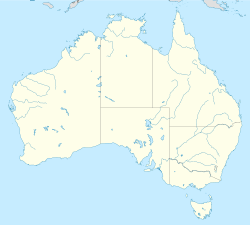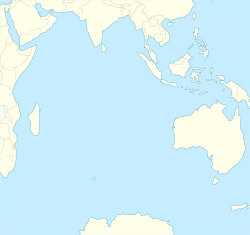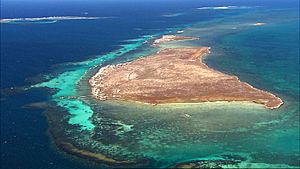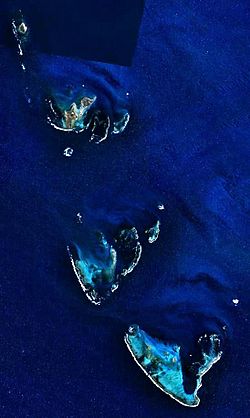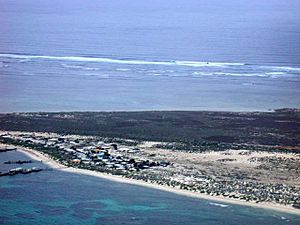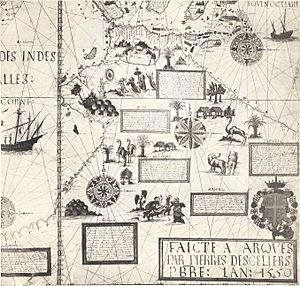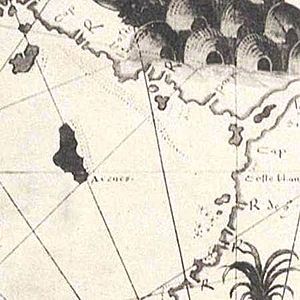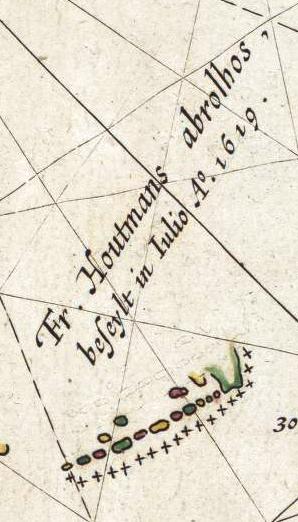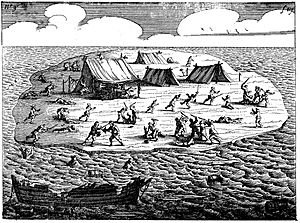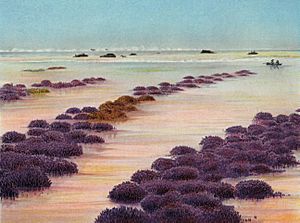Houtman Abrolhos facts for kids
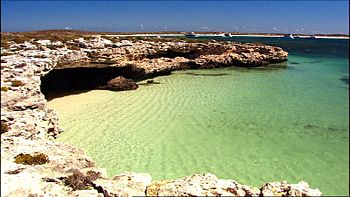
A bay in the Houtman Abrolhos
|
|
| Geography | |
|---|---|
| Location | Indian Ocean |
| Coordinates | 28°43′S 113°47′E / 28.717°S 113.783°E |
| Archipelago | Houtman Abrolhos |
| Total islands | 122 |
| Area | 16.4 km2 (6.3 sq mi) |
| Administration | |
|
Australia
|
|
| State | Western Australia |
| Federal electorates | Durack |
| State electorate | Geraldton |
| LGA | City of Greater Geraldton |
| Demographics | |
| Population | 6 (2016 census) |
| Ethnic groups | Australians |
| Additional information | |
| Southernmost true coral reef in the Indian Ocean | |
The Houtman Abrolhos (often called the Abrolhos Islands) is a group of 122 islands and coral reefs. They are located in the Indian Ocean off the west coast of Australia. The islands are about 80 kilometres (50 miles) west of Geraldton, Western Australia. This area is the southernmost true coral reef in the Indian Ocean. It is also one of the highest latitude reef systems in the world.
The Abrolhos Islands are a very important place for seabirds to breed. They are also the center of Western Australia's biggest western rock lobster fishery. A small number of fishermen live there during certain seasons. A limited number of tourists can visit for day trips. However, most of the land is protected as a habitat for wildlife. The islands are famous for many shipwrecks. The most well-known are two Dutch ships: the Batavia (wrecked in 1629) and the Zeewijk (wrecked in 1727).
The islands are an unincorporated area. This means they do not have their own local government. The Government of Western Australia manages them directly. In July 2019, the Houtman Abrolhos became a national park.
Contents
Exploring the Abrolhos Islands' Geography
The Houtman Abrolhos archipelago is in the Indian Ocean. It is about 80 kilometres (50 miles) west of Geraldton in Western Australia. The 122 islands and their coral reefs are divided into three main groups: the Wallabi Group, Easter Group, and Pelsaert Group.
The Wallabi Group
The Wallabi Group is the most northern island cluster. It is about 17 by 10 kilometres (11 by 6 miles) wide. It also includes North Island, which is 14 kilometres (9 miles) to the north-west. Key islands in this group are North Island, West Wallabi Island, East Wallabi Island, and Beacon Island. This group is famous for the shipwreck of the Batavia in 1629. This happened near Beacon Island. After the shipwreck, a terrible mutiny and massacre occurred among the survivors.
The Easter Group
The Easter Group is located southeast of the Wallabi Group. A 9-kilometre (6-mile) wide channel called Middle Channel separates them. This group is about 20 by 12 kilometres (12 by 7 miles) in size. It includes islands like Rat Island, Wooded Island, Morley Island, Suomi Island, and Alexander Island.
The Pelsaert Group
Further southeast, across Zeewijk Channel, is the Pelsaert Group. This group holds the southernmost true coral reef in the Indian Ocean. Its main islands are Middle Island, Square Island, Long Island, Pelsaert Island, Basile Island, and the Mangrove Group. Many ships have been wrecked here. The most famous is the Zeewijk, which wrecked on Half Moon Reef in 1727. The survivors lived on Gun Island for some time.
How the Abrolhos Islands are Governed
The Houtman Abrolhos Islands are part of Western Australia. They belong to the Electoral district of Geraldton and the City of Greater Geraldton. In July 2019, the Western Australian Government declared the Houtman Abrolhos a national park.
In late 2022, the government released a 10-year plan for managing the islands. This plan was based on research and community ideas. Some people felt the plan did not encourage enough land-based tourism. However, the Department of Primary Industries and Regional Development stated that their main goal is to protect the islands' wildlife.
A Look at the Abrolhos Islands' History
Aboriginal people visited these islands thousands of years ago. Evidence of their visits, like stone tools, has been found on Beacon Island.
European Discovery of the Abrolhos Islands

The first time Europeans saw the Houtman Abrolhos was in 1619. This was during a voyage by the Dutch East India Company ships Dordrecht and Amsterdam. This happened only three years after Dirk Hartog first officially sighted Western Australia. It was also just 13 years after the first European voyage to Australia by the Duyfken in 1606.
The discovery of the islands is credited to Frederick de Houtman. He was the Captain-General of the Dordrecht. Houtman later wrote about the discovery in a letter. He described finding a low-lying coast with many reefs. He warned that this area was very dangerous for ships.
The word Abrolhos comes from Portuguese. It means 'open your eyes'. Portuguese sailors used this word to describe dangerous offshore reefs. Houtman used this Portuguese word because it was common in Dutch sailing terms at the time. Some historians believe the islands were named after the Abrolhos Archipelago off Brazil. Others think it was a warning cry used by lookouts.
Some people believe Portuguese navigators charted these islands in the 16th century. They point to old maps, like the 16th-century Dieppe maps. Some of these maps seem to show the west coast of Australia. One map by Pierre Desceliers (1550) labels an island in this area as Arenes. However, many experts do not agree that Arenes is a changed form of Abrolhos.
The Houtman Abrolhos first appeared on a map in 1622. This was on a map by Hessel Gerritsz. They were shown as small circles without a name. In 1627, Gerritsz's map Caert van't Landt van d'Eendracht first named them Fr. Houtman's abrolhos. The next year, his map called them Houtman's Abrolhos. On British Admiralty charts, the islands are called Houtman's Rocks.
The Batavia Shipwreck
In 1629, some of the islands were the scene of a famous shipwreck and mutiny. The Dutch ship Batavia crashed on its first trip to Batavia (now Jakarta). The ship's commander, Francisco Pelsaert, and some crew left in a small boat to get help. The crew members who stayed behind on the islands caused a lot of trouble. They terrorized and killed many other survivors, including women and children. When Pelsaert returned, some of the people responsible were punished.
The Zeewijk Shipwreck
The Zeewijk was the last of four Dutch East Indiaman ships to wreck off Western Australia. The ship hit the Half Moon Reef on June 9, 1727. The crew and supplies were moved to nearby Gun Island. They even saved ten chests of money, weighing 3 tonnes (6,600 lb).
The Zeewijk crew was stuck on the Pelsaert Group for ten months. They ate seals, seabirds, and eggs. They also used supplies saved from the wreck. Many men died on the islands. On July 10, a small boat with eleven men was sent to Batavia for help. It never arrived. Four months later, the survivors built a new 18-metre (60-foot) boat. It was named Sloepie (meaning "little sloop"). This was the first ocean-going vessel built in Australian history. On March 26, 1728, the remaining men sailed to Batavia.
Gun Island and Phosphate Mining
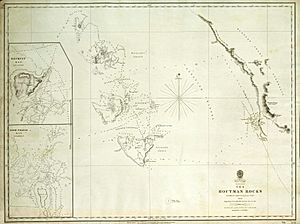
In 1840, during surveys by the British Admiralty, a brass gun was found on the largest island in the Pelsart Group. The commander, John Clements Wickham, named the place Gun Island. Later in the 1800s, many small islands were used to collect guano (bird droppings).
In 1884, Charles Edward Broadhurst got a permit to mine rock phosphate on the islands. He built a plant, a stone jetty, and tramways on Rat Island. He also built buildings on Rat, Gun, and Pelsaert islands. Over 40 Malay workers mined and processed the phosphate for export. More than 48,000 tonnes (106 million pounds) were shipped between 1884 and 1896.
Weather and Ocean Conditions Around the Abrolhos Islands
The Houtman Abrolhos Islands have a Mediterranean climate. This means they have warm, dry summers and cooler, wet winters. Temperatures are milder than on the mainland. This is because of the ocean's influence and the Leeuwin Current.
Most rain falls between April and September. June is usually the wettest month. It is almost always windy on the islands. Strong winds can occur, especially during tropical cyclones or winter gales.
Oceanography and Currents
The Houtman Abrolhos is about 60 kilometres (40 miles) off the coast of Western Australia. It is near the edge of Australia's continental shelf. The water over the shelf is shallow, less than 50 metres (160 feet) deep.
The islands are almost directly in the path of the Leeuwin Current. This current brings warm, low-salt water from tropical areas south along the coast. This current flows all year, but is strongest in winter. The Leeuwin Current helps keep the water around the islands warm. This allows tropical corals to grow here.
Sea temperatures at the islands change throughout the day and year. In summer, the water can reach nearly 24 °C (75 °F). In winter, it falls to around 20 °C (68 °F). This temperature range is much smaller than in nearby coastal waters. This is thanks to the warm Leeuwin Current.
Sea levels at the islands are small and change irregularly, similar to Geraldton. They are higher in winter when the Leeuwin Current is strongest.
Wildlife of the Abrolhos Islands
The Houtman Abrolhos Islands are very important for wildlife. Their isolation provides a safe place for animals like tammar wallabies, Australian sea lions, and rare breeding seabirds. The islands have a mix of tropical and temperate species. This creates unusual combinations, like tropical corals growing next to temperate seaweeds.
Birds of the Abrolhos Islands
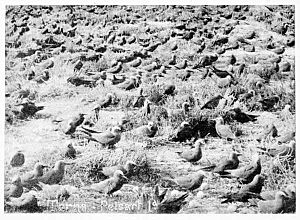
About 100 different types of birds live on the Houtman Abrolhos. Most of these are seabirds. The islands are one of the most important breeding sites for tropical seabirds in Australia. They have huge colonies of wedge-tailed shearwaters, with over a million breeding pairs. They also have Western Australia's only breeding colonies of the lesser noddy.
Two bird subspecies live only on these islands. The Abrolhos painted button-quail is found on five islands in the Wallabi Group. The Australasian subspecies of the lesser noddy breeds only on Wooded Island, Morley Island, and Pelsaert Island. Both are protected as rare species.
Mammals of the Abrolhos Islands

Only two types of land mammals are native to the Houtman Abrolhos: the tammar wallaby (Macropus eugenii) and the bush rat (Rattus fuscipes). Both are native to West and East Wallabi Islands. Tammar wallabies were first seen by Europeans on West Wallabi Island in 1629. This was the first recorded sighting of a macropod (like kangaroos and wallabies) by Europeans. Wallabies were later successfully introduced to North Island.
Some introduced mammals have lived on the islands. These include domestic cats on Rat Island and house mouses on North Island. However, other introduced animals like black rats, European rabbits, and domestic goats have been removed from the islands.
Reptiles of the Abrolhos Islands
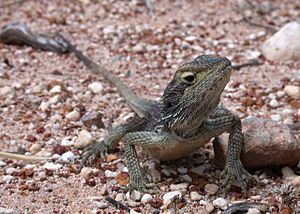
23 types of land reptiles live on the Houtman Abrolhos islands. The most important reptile species are the spiny-tailed skink (Egernia stokesii stokesii) and the carpet python (Morelia spilota imbricata). Both are protected as rare. The Abrolhos dwarf bearded dragon (Pogona minor minima) is a unique species found only on these islands.
Marine Mammals of the Abrolhos Islands
The Houtman Abrolhos has a breeding population of Australian sea lions (Neophoca cinerea). There are probably between 75 and 100 of them. In 1727, survivors of the Zeewyk shipwreck killed over 150 sea lions. This suggests there were many more back then. Sea lion populations dropped a lot in the 1800s due to hunting. Now, populations are stable, but low genetic diversity is a concern.
Sea lions rest on beaches throughout the islands. However, they only breed at a few special sites. These breeding sites are very important for conservation.
Other marine mammals are sometimes seen around the islands. These include humpback whales and southern right whales during their migrations. Pygmy Bryde's whales, orcas, and different types of dolphins are also sighted.
Coral Reefs of the Abrolhos Islands
The Houtman Abrolhos is special because it has a rich and diverse living coral reef at such a high latitude. 194 species of coral have been found here. Most of them are tropical species. This is surprising given how far south the reef is located.
The coral reef community here is unique. Tropical corals grow alongside and compete with temperate seaweed. Because of this competition for light and space, corals here grow slower and die younger than usual.
Crustaceans and Molluscs of the Abrolhos Islands
The most important crustacean species at the Houtman Abrolhos is the western rock lobster (Panulirus cygnus). Many types of crabs and other small crustaceans also live here.
492 species of marine molluscs have been found in the shallow waters. These include snails (gastropods) and clams (bivalves). About two-thirds of these species are tropical. The southern saucer scallop (Amusium balloti) is the only commercially important mollusc species.
Human Activities and Uses of the Abrolhos Islands
Fishing and Tourism
Fresh water has always been a challenge for people living on the islands. Only a small number of fishermen live there seasonally. They have homes elsewhere, mostly in Geraldton. Their island shacks are used as a base during the fishing season. For example, North Island has a seasonal camp for western rock lobster fishers. During lobster season (March to June), up to 130 people might be on the island.
Tourists are not allowed to camp overnight. The islands' protected status limits how much human activity can expand.
Western Rock Lobster Fishery
The islands are the main area for the western rock lobster fishery. This is the biggest single-species fishery in Western Australia.
Saucer Scallop Fishery
After Shark Bay, the Houtman Abrolhos has Western Australia's second largest saucer scallop fishery. Only 17 licenses are given out for this fishery. This is because the saucer scallop population is carefully managed. Scallop fishing usually happens from April to June. Catches can change a lot from year to year. The value of this fishery was A$19.6 million in 2003. Most of the scallops are frozen and sent to Asia.
Finfish Fishing
Some wetlining (fishing with lines and hooks) also happens around the Houtman Abrolhos.
Aquaculture (Farming Seafood)
The Department of Fisheries has given out licenses to grow black-lip pearl oysters in the Abrolhos. The first license was given in 1996. By 2007, eight licenses had been issued. Most of this pearl farming happens in the Pelsaert Group. The pearls produced here have a unique color.
A trial farm for finfish in sea cages was licensed in 2004, but it has not started operating yet. There is also interest in growing "live rock" and coral for the aquarium industry. The Department of Fisheries has identified other species that could be farmed here. These include the Shark Bay pearl oyster, maxima clams, rock oysters, and more finfish.
Recreation and Fun
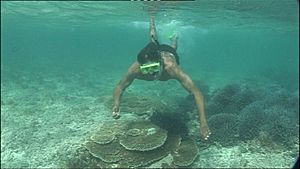
The Abrolhos offers some of the best snorkelling, diving, and deep-sea fishing in the world. It also has important historical sites, like the Batavia shipwreck. Even though it's a popular tourist spot, visitors are not allowed to stay overnight.
See also
 In Spanish: Houtman Abrolhos para niños
In Spanish: Houtman Abrolhos para niños



